I found the Goodell-Pratt number #259 (I originally thought 5 1/2B) eggbeater drill at Liberty Tools in Liberty, Maine. Liberty Tools is a galoot’s paradise where one has little choice but to spend money. This drill went for $28. We put it to use immediately at the Wooden Boat School, drilling and setting screws on the boats we were building. We quickly discovered that it’s a very versatile drill. In addition to the usual drilling action, there is a fast / slow selector that alternates gearing ratios. The fast speed is great for drilling pilot holes and most screw setting. Switch to slow when more torque is needed. Then, there’s a ratchet mechanism too. See the R I L indications on the round plate under the hand crank? R and L set ratcheting for Right or Left. The I setting locks up tight, no ratcheting. This makes the drill very handy for working in tight spaces where’s there not enough room to fully spin the crank. Quite a nice eggbeater!
Other than wiping the handle clean so it didn’t stick to my hands, the way shoes stick to the floors in movie theaters, we did no other clean up. There is a patent date of Aug 13 1885. The next patent date found on that model drill is 1905. So, this one was manufactured sometime between those two dates. (Update: the ratchet mechanism was added in the early 1920s, making the 5 1/2B into the #259. Thanks Rick.) It had a fair amount of grunge, but not bad enough to affect smooth operation. We used it at the school. I then brought it home and used it in building a workbench and the first boat. Still no clean up. (Click the picture on the right to see 100+ years of “ambiance.”)
Being between projects, I’m following Stephen Covey’s habit #7: Sharpen the Saw. Actually, the saw was sharpened last week. This week I refurbished the eggbeater. Here’s where the traditional collectors will howl. Instead of doing the minimal (don’t harm the patina) restoration, I stripped it down, polished, and repainted. It’s not a collector’s item. It’s “a user.” So, I’m not worried about the howls. Three coats of fresh paint went on the metal parts. a new side knob of mahogany replaces the one that was lost. A bit of red stain brought the knobs and handles into harmony before receiving three coats of Minwax Polycrylic satin finish. Polishing the bare metal parts brought back their luster. One of the compression springs inside the chuck was badly deformed. I wound a new one from the steel core of a well used guitar string. (Don’t ever throw away used guitar strings.) Lubed and reassembled, the drill runs as smoothly as one could want, and looks almost as nice as Wictor Kuc’s. Ready for another hundred years.
Update: A discussion over at the Sawmill Creek forums has Mike asking about the speed shifter on a Millers Falls drill. Although different in how the speeds are selected, I’m guessing the internal mechanism is similar. Following are 4 pictures showing my cautious step-by-step disassembly of the shifter. It turns out to be a simple device. The internal sleeve has ears on each end and is keyed to the collet shaft. Those ears engage either one pinion or the other. The little shift wheel on the frame moves a peg that slides the sleeve to one pinion or the other.
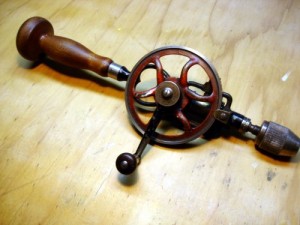
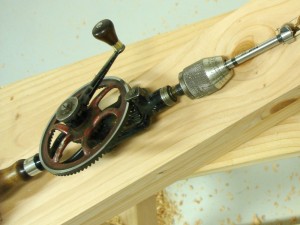
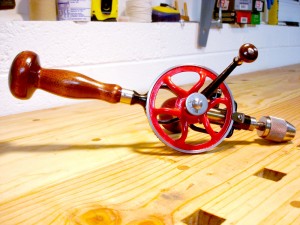
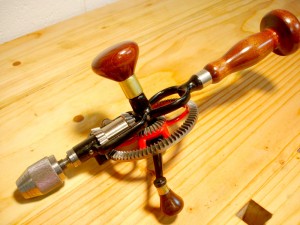
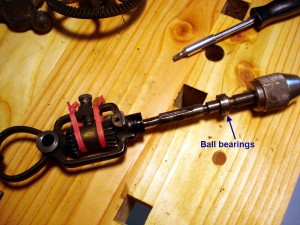
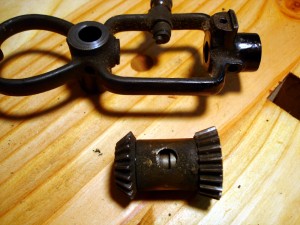
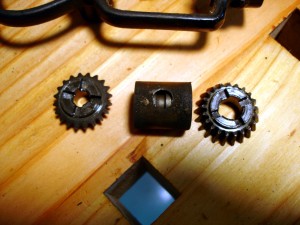
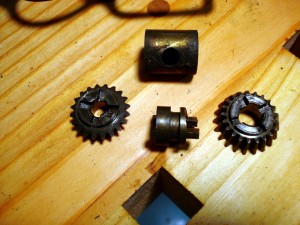
Thanks for the details! Your end results are great and definitely good enough for “use”. What a great blog you have.
I didn’t bother painting (yet) but did the rest of the overhaul including making guitar string springs. Thanks again for all the awesome info!
Good to hear your progress Rob. Enjoy your smoother running eggbeater! Once you have one that works well, it’s amazing how often it gets used.
Recently came across your website, I have for sale a #5 1/2 B Goodell-Pratt hand drill. All original except middle handle(opposite crank)was replaced. Private seller. Any interest?
P.E. Howes
Nice, and in good condition. I recently found #259 at a garage sale, they wanted $20 for it and I got it for $10. Over the years I have picked up several Goodall Pratt but more Millers Falls hand drills.
Michael
Millers Falls Hand Drills
Hello,
a couple of years ago i bought an old hand drill from Goodell Pratt – unfortunately without drill chuck – for a few Euros from a junk dealer in Berlin / Germany.
http://www.fotocommunity.de/pc/pc/cat/6170/display/34054700
It seems to be an old model – patented 1891.
I just purchased a MF’s No. 5…I am acing difficulty getting the chuck to open…help
Ooh that is a most beautiful restoration well done.
Bob,
Great restoration! Just picked one of these up in a grab-bag sale. It’s missing most of the chuck and the chef’s hat side handle. I’m new at this and eager to get it up and running. Any ideas on where to look for my missing parts?
Dave
Hello Dave,
You might try eBay for the chuck. I see one there right now, from a different drill, but might fit.
I made the side handle by turning a piece of mahogany, epoxying on a nut and covering with a brass ferrule. In reality, that handle doesn’t get much use.
Good luck with the restoration. They are sweet running drills; a real pleasure to use.
Looks great! I’m also in the middle of restoring a Goodell Pratt 5 1/2. How did you manage to get that handle off?
Hi Simon,
The handle on the drill I have is held with a pin. I simply punched it out, and reinstalled it after the rest of the restoration work. The pin goes through the metal collar and was quite obvious on mine. It may be different on yours.
In the off chance that you or anyone still reads this post …. I have the 259 and the chuck needs new springs. I saw the post about making springs out of piano wire and I might give that a shot. Is there supposed to be a metal plunger/disc/cylinder that pushes upward on the three jaws as they close? Or does the inner edge of each jaw simply get pushed up by the threaded shaft?
Hi Ryan,
There is a cylinder shaped metal casting/turning, with a cone on top, that floats in the bottom of the chuck. It does indeed move the jaws upward as they close.
Hi ALL
I have a Goodell Pratt hand drill. My question is, the spring loaded pin on the side of what it is for? Does engaging it change the speed? Lastly, how do I know if it is a #259 or a 51/2B? Please advise me on this. Thanks
I am curious and I have been looking but have not seen any answer to this at all. Do the gears of this egg beater drill, or any of its parts gets greased or oiled? I see what appears to be oil holes in a couple of mine, And it makes sense oil would go there, but does the large tooth wheel possibly get grease or oil, or maybe nothing? Thank you
Bob,
Thanks for keeping this page up. It is pretty much the only page that has any detailed information on the 259. I picked one up for a few dollars at a garage sale and was quite surprised at the price that this drill goes for as well as it’s versatility. The 259 I own is in much the same condition yours was in originally, fully functional, extremely useful and missing the side handle. I am about to embark on a complete tear down and restoration. Mostly due to some play in the bearings as well as both the ratcheting and gear adjustments being a little difficult to turn, they like to stick a little. Since I’m going to have it apart I might as well do the entire restoration. My question is regarding the side handle. I have a screw and brass hardware that fit from a donor drill. The handle from that drill is long and relatively straight. I would like to turn a mushroom style handle but I don’t have anything to compare it to for the appropriate size. Did you just wing it and get it close or duplicate one from another Goodell Pratt drill? If you have the height and the top diameter it would be appreciated. Also the original handle on the crank looks to be rosewood while the top must be mahogany. Do you know if the original side handle was mahogany, matching the mushroom top or rosewood, matching the crank handle? I might be able to scavenge some rosewood from an old brace or two to match the original if needed.
Thanks,
Andy
Hello Andrew,
The knob was missing from my drill when I bought it from that great old tools store in Maine. I turned a new one using no pattern. I just made something that works. It ended up 2 1/8″ in diameter, 1 1/8″ deep (crown to bezel edge), with a 7/8″ brass bezel from the used parts bin. I tuned mine from some African Mahogany I had on hand.
No matter what materials you use, I’m sure you’ll have a fine drill to use for a long time. Enjoy!